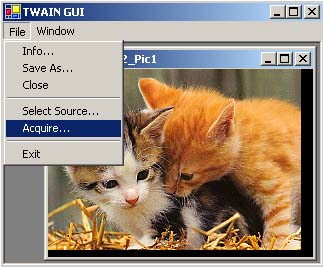
Abstract
In Windows imaging applications, the most used API for scanning is TWAIN www.twain.org. Unfortunately, the new .NET Framework has no built-in support for TWAIN. So we have to work with the interop methods of .NET to access this API. This article doesn't explain this interop techniques, and good knowledge of theTWAIN 1.9 specifications is assumed! The sample code included doesn't present a finished library, only some essential steps for a minimal TWAIN adaption to .NET applications.
Details
First step was to port the most important parts of TWAIN.H, these are found in TwainDefs.cs. The real logic for calling TWAIN is coded in the class Twain, in fileTwainLib.cs.. As the TWAIN API is exposed by the Windows DLL, twain_32.dll, we have to use the .NET DllImport mechanism for interop with legacy code. This DLL has the central DSM_Entry(), ordinal #1 function exported as the entry point to TWAIN. This call has numerous parameters, and the last one is of variable type! It was found to be best if we declare multiple variants of the call like:
[DllImport("twain_32.dll", EntryPoint="#1")]
private static extern TwRC DSMparent(
[In, Out] TwIdentity origin,
IntPtr zeroptr,
TwDG dg, TwDAT dat, TwMSG msg,
ref IntPtr refptr );
The Twain class has a simple 5-step interface:
class Twain
{
Init();
Select();
Acquire();
PassMessage();
TransferPictures();
}
For some sort of 'callbacks', TWAIN uses special Windows messages, and these must be caught from the application-message-loop. In .NET, the only way found wasIMessageFilter.PreFilterMessage(), and this filter has to be activated with a call like Application.AddMessageFilter(). Within the filter method, we have to forward each message to Twain.PassMessage(), and we get a hint (enum TwainCommand) back for how we have to react.
Sample App
The sample is a Windows Forms MDI-style application. It has the two TWAIN-related menu items Select Source... and Acquire... Once an image is scanned in, we can save it to a file in any of the GDI+ supported file formats (BMP, GIF, TIFF, JPEG...)
Limitations
All code was only tested on Windows 2000SP2, with an Epson Perfection USB scanner and an Olympus digital photo camera. The scanned picture is (by TWAIN spec) a Windows DIB, and the sample code has VERY little checking against error return codes and bitmap formats. Unfortunately, no direct method is available in .NET to convert a DIB to the managed Bitmap class... Some known problems may show up with color palettes and menus.
Note, TWAIN has it's root in 16-Bit Windows! For a more modern API supported on Windows ME/XP, have a look at Windows Image Acquisition (WIA).






















 859
859











 被折叠的 条评论
为什么被折叠?
被折叠的 条评论
为什么被折叠?








